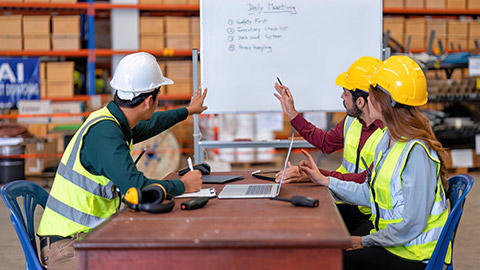In this section you will learn to:
- Support workplace consultative procedures by encouraging work team participation in consultative activities
- Encourage and assist work team members to contribute to WHS
Supplementary materials relevant to this section:
- Reading F: Sample WHS Consultation Procedures
Consultation is an important part of effective WHS processes. This section of the module is designed to help you understand the importance of consultation and how workers can support consultation, cooperation, and communication in relation to WHS activities.
Watch
Under the WHS Act, the PCBU has a duty to consult their workers on WHS matters. They also have a duty to consult, cooperate, and coordinate activities with other duty holders (e.g., suppliers, contractors, and building owners) who may influence how work is carried out in the workplace. While the PCBU is the main person who holds this duty, the officers (e.g., managers, directors, coordinators, and other representatives) must exercise due diligence to ensure that these duties are fulfilled.
In practical terms, WHS consultation is a two-way communication process between PCBUs/officers and their workers with the intention of:
- Sharing relevant work health and safety information
- Providing workers with the opportunity to express their views and raise health and safety matters
- Enabling workers to contribute to the decision-making process relating to health and safety matters
- Taking into account the views of workers
- Advising workers of the outcome of any consultation in a timely manner.
(Safe Work Australia, 2022)
Consulting with workers can provide valuable information about hazards in the workplace and allows PCBUs/officers to make informed decisions about safe work practices. While consultation is a legal requirement, there are also additional benefits for conducting consultation. These include:
- Greater awareness and commitment – because workers who have been actively involved in how health and safety decisions are made will better understand the decisions
- Positive working relationships – because understanding the views of others leads to greater co-operation and trust
(Safe Work Australia, 2023. p. 9)
Although consultation may not always result in agreement, the organisation’s commitment to open communication regarding WHS matters will contribute to higher effectiveness and compliance with the decisions. Practical guidelines on consultation, cooperation, and coordination regarding WHS matters can be found in the Model Code of Practice available on Safe Work Australia website.
Watch

According to the guidelines from Safe Work Australia (2016), WHS consultation should take place when:
- identifying hazards and assessing risks arising from work
- proposing changes that may affect the health and safety of workers, and
- whenever specifically required to do so under particular regulations.
and when considering making decisions about:
- ways to eliminate or minimise risks
- the adequacy of facilities for workers’ welfare at work
- procedures for consulting with workers
- procedures for resolving health and safety issues
- procedures for monitoring the health of workers or workplace conditions, and
- how to provide health and safety information and training to workers.
(Safe Work Australia, 2023, p.10)
Understandably, there will be times when there is emergency WHS issues and it will not be possible to consult everyone. However, so far as reasonably practicable, there are two main categories of people who need to be consulted regarding WHS matters:
- Those who carry out work for the PCBU – workers or their representatives (i.e., Health and Safety Representatives or a Health and Safety Committee).
- Those who are (or likely to be) directly affected by these health and safety decisions (e.g., contractors and their workers, volunteers, clients, etc.) Under WHS legislation, workers may request to nominate one or more workers to speak in their place on WHS matters. These workers will take on the role of Health and Safety Representative (HSR). To elect a HSR, work groups must first be established by grouping workers who share a similar work situation. For example, if your organisation provides services in multiple sites, workers who work at the same site can be considered as a work group as they are likely to face similar WHS issues. Work groups may also be established based on nature of work (e.g., outreach workers, administrative staff, etc.) or work hours and patterns (e.g., night shift, volunteer, part-time, etc.). If HSRs are elected in your organisation, you will be required to liaise with them while consulting on WHS matters.
In some organisations, a Health and Safety Committee (HSC) is also formed to “facilitate cooperation between a PCBU and workers in developing and carrying out measures to ensure health and safety at work” (Safe Work Australia, 2020, p.
- The members of this committee will meet on a regular basis to discuss WHS matters and spend reasonable work time to carry out relevant duties. Where there is a HSC in your organisation, you will also need to consult and liaise with the committee to develop consultative WHS activities with workers.
Other than employees of your organisation, it is also important to consult with others who may be affected by the health and safety decisions made in your organisation (for example, other organisations/contractors conducting similar work in the same place). In the context of an allied health organisation, it may also be necessary to consult with volunteers and clients to ensure that their needs and concerns are being looked after (WorkSafe Victoria, 2006).
Self-Reflection
Before reading on, take a moment to reflect on your workplace or a workplace that you are familiar with. Are workers consulted in regard to WHS matters? If so, how are workers being consulted?

There is no legal requirement as to how WHS consultation should take place; however, it is good practice for management to engage in discussions with workers to determine the most effective consultative activities for the organisation.
The Code of Practice from Safe Work Australia (2022) recommends PCBUs/officers chose consultative activities that:
- Fulfil the duty to consult
- Ensure participation of all workers with consideration of part-time, shift or mobile workers
- Best integrate with the organisation’s management of WHS
PCBUs/officers of a relatively small allied health organisation may be able to consult each of the workers directly. The consultative process could be formal (e.g., a WHS process review) or informal (e.g., catch up over morning tea), and either in a one-on-one, small group, or team meeting context. However, if the organisation is of medium or large size, consulting each worker directly may not be practical. In these cases, you would most likely consult the workers through their representatives – HSRs and/or HSCs – in regard to WHS matters.
It is good practice to for workers and their representatives to be provided with relevant information about matters pertinent to their health and safety as early as possible. It is not only a legal requirement but also allows time for workers to consider and contribute to the discussions in an informed and constructive manner. Information that needs to be provided may include technical guidance about workplace hazards and risks, hazard reports and risk assessments, proposed changes to the workplace, data on incidents, illness or injuries, and health and safety policies and procedures (Safe Work Australia, 2022).
Alternatively, WHS consultation can also be tailored to your organisation by establishing agreed consultation procedures with workers. Consultative activities may include:
- Informal catch up with workers
- Team meetings to talk about WHS matters
- Briefing sessions on new WHS policy and procedures
- Toolbox talks
- WHS newsletters or information sheets
- Suggestion box/email for workers to send suggestions about WHS matters
- Updating internet/intranet-based information regarding WHS
- WHS surveys
Regarding the above points, WHS meetings allow workers, supervisors, and managers to work together to identify and report issues and near misses. Rather than formal WHS meetings, some organisations may instead have WHS on the agenda for regular staff meetings. Regardless of which type, all discussions regarding WHS issues should be recorded, and followed up. WHS Surveys and tools may be used for consultation activities regarding issues of concern in the workplace. Lastly, regarding research and reports, information such as records of overtime, time off, incident, injury, and near miss reports, risk assessments, and workers compensation may be beneficial to understanding where they may be gaps or issues that need to be addressed.
It is important to conduct regular consultation instead of simply leaving it to when issues arise so that WHS issues can be identified and resolved in the early stages. For greater efficiency, PCBUs/officers should consider integrating WHS consultation into regular discussions undertaken in the organisation instead of establishing separate WHS consultative meetings. For example, WHS can be incorporated as a standard agenda item of weekly team meetings. Some workplaces may also require a mix of consultative activities to meet the needs of different workers and situations. For example, a few workers who work at remote locations will be consulted directly while the rest of the workers will be consulted via their HSRs. Ultimately, the goal is to ensure workers are provided with reasonable opportunities to contribute feedback on health and safety issues and that their views are considered when making relevant decisions.
Reading F – Sample WHS Consultation Procedures
Agreed procedures for WHS consultation should be documented in the WHS policy and procedures of the organisation and communicated to all workers. A template of a WHS consultation procedure is included in Reading F.
As you complete Reading F, attempt to find the following information:
- When does consultation occur? Who is being consulted?
- How are the consultation processes being carried out?
- What are the roles of workers and HSRs?
Barriers to Effective Consultation
As with all communication, you will come across barriers that prevent efficient consultation. The following extract provides some examples and tips regarding such barriers.
There are many barriers to how we communicate and consult with each other in the workplace. Finding the right time and delivering messages in the right way can be a challenge. Workers and HSRs should establish a relationship with their manager that encourages open and honest discussion and mutual trust. Consultation often fails due to:
- Lack of clarity of message
- Absence of emotional resonance in your message
- Inaccurate targeting
- Poor timing
- No genuine feedback process.
Tips to reduce barriers through communication:
- Engage people on an emotional level
- Provide clear messages with concrete examples to help people focus their energies
- Think about what you say and how you say it (is what you are saying aligned with what you are feeling and thinking?)
- Written material should be backed up by verbal communication
- Check the tone of the communication (edit, edit and edit again)
- Some news is better than no news
- Let people know the status of what is happening, you are the key in communicating change, workers look to you to see if there is real acceptance.
(Mining and Quarrying Occupational Health and Safety Committee, 2019, p. 11)
Once consultation arrangements have been developed, they must be implemented and regularly reviewed in collaboration with workers and health and safety representatives. This is to ensure that the current consultation arrangements continue to be effective in fulfilling the duty to consult as well as in enabling workers to contribute feedback on health and safety issues.
There are a number of processes that can be used to review consultation arrangements, but one of the most common involves the use of compliance checklists. An example of a consultation compliance checklist provided by Safe Work Australia (2011, p. 23) is included on the following page.
| Consultation compliance | Yes/No |
|---|---|
| Do I have one or more consultation arrangements in place after consultation with my workers? | |
| Do the consultation arrangements include workers other than my employees such as contractors or labour hire workers who are part of my workforce? | |
|
Do I use my consultation mechanism when I:
|
|
When I consult with my workers on these issues do I:
|
|
If workers are represented by a health and safety representative, do I:
|
|
Do I consult other duty holders who share responsibility for a health and safety matter with me?
|
Alternatively, PCBUs/officers may use effective consultation checklists (such as the example shown on the next page) to survey workers on the effectiveness of the consultation arrangements.
|
Effective Consultation in Your Workplace Effective consultation is mandatory under the WHS Act. You may find this checklist helpful. It is based on the WHS Consultation, Cooperation, and Coordination Code of Practice. |
|
| In your workplace, is consultation a two-way process between the PCBU and workers where they: | |
|
☐ |
|
☐ |
|
☐ |
| Are workers encouraged to: | ☐ |
|
☐ |
|
☐ |
|
☐ |
|
☐ |
| And: | ☐ |
|
☐ |
|
☐ |
|
☐ |
|
☐ |
|
☐ |
(Adapted from Courtenell Pty Ltd, 2013)

It is important for workers to participate in consultations about potential workplace changes as it may impact their ability to do their work or could introduce new/other hazards. Workers are the ones who are generally most effected by WHS issues; they are the ones who encounter majority of hazards and risks, use workplace equipment and tools, know how things work and what would work best in practical terms for the safety, health, and wellbeing of workers.
Workers should be encouraged to report all WHS incidents and be provided with easy, simple templates for formal reporting. Reporting can initially be informal and verbal, but officers must make sure that reporting is carried out as soon as possible in consideration of the event. All incidents must be investigated by officers or PCBUs of the organisation and the outcomes must be recorded. A detailed outline must be made of the steps that will be taken to ensure it does not happen again, when they will be taken, by whom and by when they will be completed.
Through consultation with workers and their representatives, PCBUs/officers are able to obtain feedback about possible ways to manage the hazards and risks in the organisation. Consultation may also reveal the presence of work practices that are likely to cause accidents or injuries to workers or the presence of training gaps in workers. It is important to provide appropriate training to all workers so that they are aware of unsafe work practices and trained to conduct work in a safe and healthy manner.
In order to encourage workers to express their views and contribute to health and safety decisions, PCBU’s, officers, or representatives should:
- Provide appropriate opportunities during work hours for consultation with workers with consideration of different work types (e.g., shift work, casual, contract, part-time etc.)
- Foster an environment of openness and encouragement by allowing opinions about health and safety to be regularly discussed and considered during workplace meetings
- Provide workers with various avenues for feedback such as email, setting up an intranet health and safety page, or a suggestion box
(Safe Work Australia, 2022)
If your organisation gathers feedback from workers using indirect avenues such as email, suggestion box, organisational intranets, and comment boxes, these should be monitored to determine their effectiveness, both with regards to quantity and quality. For example, it would be best to use the option that is deemed most effective for workers to provide feedback and to understand the reasons behind it. Moreover, lack of confidentiality in the options provided would also discourage workers from giving their honest opinions. If there seems to be limited WHS feedback provided by workers, it may be necessary to review the options available and consider different approaches that are more engaging to workers or schedule meetings to prompt WHS discussion among workers.
Barriers to Participation
A part of encouraging and assisting others to contribute to WHS and consultative activities involves understanding why some people may be hesitant to contribute to WHS. There may be several factors at play, such as discrimination or harassment in the workplace, an unstable or unsafe workplace, fear regarding real or imagined repercussions or consequences, confusion over policies and procedures, conflict or poor workplace relationships, or misinformation or lack of information. In order to overcome these barriers to participation, it may be beneficial to provide advice regarding where to find policies and procedures, understand what they mean, assist team members to fill out feedback forms or reports, support the team member to approach their manager/supervisor regarding the issue, or appease any concerns regarding attending meetings or providing feedback on WHS issues as/when requested.
Consultation is a vital aspect of effective WHS. It helps ensure that WHS processes meet the needs of workers and that workers are engaged with WHS processes. In this section of the module you learned about some of the most common practices involved in WHS consultation, and how best to encourage and assist team participation in WHS consultative activities.
Courtenell Pty Ltd. (2013.) Effective Consultation in Your Workplace. https://www.courtenell.com.au/single-post/2014/05/22/ysm-105-effective-consultation-in-your-workplace
Mining and Quarrying Occupational Health and Safety Committee. (2019). Workplace Consultation and Communication Guide. https://www.maqohsc.sa.gov.au/__data/assets/pdf_file/0005/891599/Workplace-Consultation-and-Communication-Guide_MAQOHSC_2019.pdf
Safe Work Australia. (2020). Guide to the Model Work Health and Safety Act. https://www.safeworkaustralia.gov.au/doc/guide-model-work-health-and-safety-act
Safe Work Australia. (2022). Code of Practice: Work Health and Safety Consultation, Cooperation and Coordination. https://www.safeworkaustralia.gov.au/doc/model-code-practice-work-health-and-safety-consultation-cooperation-and-coordination
SafeWork South Australia. (2014). Community workers: Work health and safety guidelines. https://www.safework.sa.gov.au/__data/assets/pdf_file/0003/140772/Community-Workers-work-health-and-safety-guidelines.pdf
WorkSafe Victoria. (2006). Working safely in community services. https://www.worksafe.vic.gov.au/resources/working-safely-community-services
